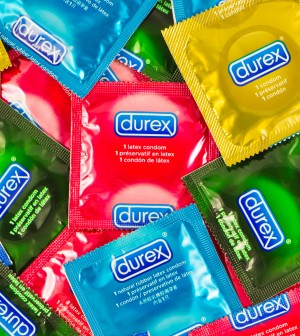- Skip Storing This Everyday Product in the Fridge Door
- Green Tea + B3 Pairing May Boost Brain Health
- Navigating Your Midlife Crisis: Embracing New Possibilities
- City Raccoons Showing Signs of Domestication
- Mapping the Exposome: Science Broadens Focus to Environmental Disease Triggers
- One Week Less on Social Media Linked to Better Mental Health
- Your Brain Changes in Stages as You Age, Study Finds
- Some Suicide Victims Show No Typical Warning Signs, Study Finds
- ByHeart Formula Faces Lawsuits After Babies Sickened With Botulism
- Switch to Vegan Diet Could Cut Your Greenhouse Gas Emissions in Half
CDC: Too Few Schools Teach Prevention of HIV, STDs, Pregnancy

Too few U.S. schools teach students how to protect themselves from HIV and other sexually transmitted diseases, how to prevent pregnancy, and other important sexual health information, federal officials reported Wednesday.
In most of the country, fewer than half of high schools and only one-fifth of middle schools teach all 16 sexual health education topics recommended by the U.S. Centers for Disease Control and Prevention.
In 44 states, the proportion of high schools that teach all 16 topics in grades 9, 10, 11 or 12 ranges from 21 percent in Arizona to 90 percent in New Jersey. Only three states — New Hampshire, New Jersey and New York — have more than 75 percent of high schools teaching all of the topics.
The proportion of middle schools that teach all 16 topics in grades 6, 7 or 8 ranges from 4 percent in Arizona to 46 percent in North Carolina. No state had more than half of middle schools teaching all the topics, and in most states it was less than 20 percent of middle schools, the CDC report said.
“We need to do a better job of giving our young people the skills and knowledge they need to protect their own health,” Dr. Jonathan Mermin, director of CDC’s National Center for HIV/AIDS, Viral Hepatitis, STD, and Tuberculosis Prevention, said in an agency news release.
“It’s important to teach students about healthy relationships and how to reduce sexual risk before they start to have sex,” he added.
Dr. Stephanie Zaza, director of CDC’s Division of Adolescent and School Health, said: “Lack of effective sex education can have very real, very serious health consequences.
“Young people who have multiple sex partners, don’t use condoms, and use drugs or alcohol before sex are at higher risk for HIV and other sexually transmitted infections. School-based sex education is a critical opportunity to provide the skills and information they need to protect themselves,” she said.
Half of all sexually transmitted diseases and nearly one-fourth of HIV diagnoses in the United States occur among people younger than 25. About 47 percent of American teens have had sex, including 30 percent of those in grade 9. In 2013, 15 percent of teens said they had had sex with four or more partners, according to the report.
Condom use among teens fell from 63 percent in 2003 to 59 percent today, and 22 percent of teens said they drank alcohol or used drugs the last time they had sex.
The report was released Dec. 9 at the National HIV Prevention Conference in Atlanta.
More information
The American Academy of Pediatrics has more for teens on healthy decisions about sex.
Source: HealthDay
Copyright © 2025 HealthDay. All rights reserved.










